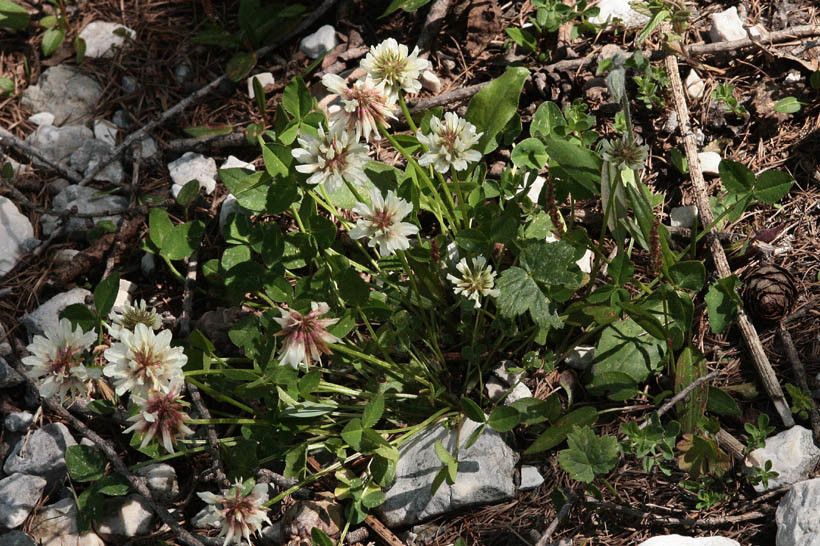Pale clover
trifolium pallescens
Also known as: ["Pale clover","Pale trefoil"]
Overview
A species of clover native to certain regions, characterized by its pale flowers and trifoliate leaves.
Benefits & Perks
["wildlife attractant (bees, butterflies, birds)","drought tolerant","low maintenance"]
Botanical Classification
| Phylum: | Magnoliophyta |
| Class: | Magnoliopsida |
| Order: | Fabales |
| Family: | Fabaceae |
| Genus: | Trifolium |
| Botanical Name: | Trifolium pallescens |
Plant Characteristics
Basic Information
- Category: Flowers
- Suitable Location: garden bed or container in a location with good air circulation
- Suitable For:
- Is Weed: No
- Allergenicity: low
Environmental Needs
- Climate: {"temperatureRange":"5–30°C"}
- Hardiness: {"zones":"6–9"}
- Misting: rarely required, only if ambient humidity is very low
- Drainage: Fast-draining to prevent waterlogging.
- Soil Type: Well-draining, loamy soil with organic matter; avoid heavy clay.
Maintenance Level
- Maintenance Level: low
- Toughness Level: moderate
- Pruning Frequency: After flowering or every 2–3 months to maintain form.
- Pruning Intensity: Light to moderate; avoid heavy pruning unless necessary.
Care Details
Ideal Sunlight Coverage:
Full sun to partial shade (4–6 hours of direct sunlight daily); adjust for intense summer sun.
Sunlight Tolerance Tips:
Acclimate plants gradually to direct sunlight; protect from harsh midday sun; provide shade during extreme heat.
Care Requirements
Care Difficulty
easymoderate
Sunlight
full sun to partial shade
Rotate plants for even light exposure; use sheer curtains to filter intense sun; avoid placing in drafty areas.
Watering
every 7–10 days during active growth, reduce in winter
Water thoroughly but infrequently; ensure proper drainage; avoid wetting foliage.
Soil
well-draining, loamy soil with moderate organic content
pH: Slightly acidic to neutral (pH 6.0–7.0).
Use a mix of potting soil and perlite; avoid compacted soil; ensure pots have drainage holes.
Temperature
Prefers cool to moderate temperatures (60–75°F or 15–24°C); tolerates light frost.
Avoid sudden temperature changes; protect from drafts; maintain consistent humidity.
Fertilizing
every 4–6 weeks during growing season with balanced liquid fertilizer
Fertilize sparingly to prevent nutrient burn; apply after watering to avoid root shock; flush soil occasionally to prevent salt buildup.
Propagation
Methods
Stem cuttings or division; stem cuttings are more common for home growers.
Step-by-Step Propagation Guide
- Take a 4–6 inch cutting.
- Remove lower leaves.
- Dip in rooting hormone (optional).
- Plant in medium.
- Keep moist and warm.
Best Time: Spring or early summer when the plant is actively growing.
Environment
Warm, humid environment with indirect light; maintain consistent moisture.
Medium
Well-draining potting mix with perlite or sand; can also root in water.
Hormone
Rooting hormone is optional but recommended for faster rooting.
Timeline
Roots typically form in 2–4 weeks; new growth may take 6–8 weeks.
Tools Needed
Pruning shears, rooting hormone, small pots, well-draining mix.
Quick Tips
Use healthy, non-flowering stems; maintain humidity with a plastic bag; avoid direct sunlight.
Pruning & Repotting
Pruning Guide
Method
Pinch back tips or cut stems just above a leaf node; remove dead or leggy growth.
Pruning Plan
Prune to maintain shape, encourage bushier growth, and remove spent flowers.
Tools
Clean pruning shears or scissors.
Checklist
Sterilize tools; prune after flowering; remove dead growth; shape as needed.
Repotting Guide
Best Season
Spring, before the active growing season begins.
Pot Size
One size up (e.g., from 4-inch to 6-inch pot); ensure good drainage.
Method
Remove plant gently; trim roots if crowded; place in a slightly larger pot with fresh soil; water lightly.
Suggestions
Repot every 1–2 years or when roots fill the pot; beneficial for growth and drainage.
Checklist
Choose appropriate pot size; use fresh soil mix; ensure drainage holes; water after repotting.
Advanced Care Tips
Watering Mastery
Watering Checklist
Check soil moisture; water deeply; ensure drainage; avoid wetting leaves.
How to Apply Water Properly
Water at the base of the plant, ensuring moisture reaches the root zone; allow excess water to drain away; water early in the day to minimize evaporation.
Watering Schedule Tips
Water deeply once the top inch of soil feels dry; reduce frequency in winter to prevent root rot.
Soil Improvement
Add perlite or sand for drainage; incorporate compost for fertility; ensure good aeration.
Temperature Stress Management
Signs of Temperature Issues
Wilting, yellowing leaves, or stunted growth in extreme heat; leaf drop or browning in cold stress.
Cold Stress
Slows growth; may cause leaf discoloration or dieback in prolonged cold.
Solution: Provide frost protection; move potted plants indoors; avoid overwatering in cold conditions.
Hot Stress
Leaves may scorch, wilt, or drop; flowering may be reduced.
Solution: Provide shade during peak heat; increase watering; improve air circulation.
Fertilizing Guide
Fertilizing Checklist
Use diluted fertilizer; apply during active growth; avoid winter feeding.
Fertilizing Method
Use a balanced liquid fertilizer diluted to half strength every 4–6 weeks during growing season; avoid fertilizing in winter.
Common Problems & Solutions
Toxicity Warning
Cats
Non-toxicTrifolium pallescens is not known to be toxic to cats. It does not pose a significant risk if ingested or handled by felines.
⚡ Toxic If:
Not applicable
Dogs
Non-toxicTrifolium pallescens is not known to be toxic to dogs. It does not pose a significant risk if ingested or handled by canines.
⚡ Toxic If:
Not applicable
Humans
Non-toxicTrifolium pallescens is not known to exhibit toxic properties to humans. It is generally considered safe for consumption and handling.
⚡ Toxic If:
Not applicable
Frequently Asked Questions
Q: Is Trifolium pallescens toxic to pets?
A: No, it is non-toxic to dogs and cats.
Q: What are the common uses of this plant?
A: It is primarily used for ornamental purposes and as a wildlife attractant.
Q: How often should it be watered?
A: It is drought-tolerant and requires minimal watering, especially in well-drained soil.
Quick Reference
| Family: | Fabaceae |
| Care: | easy |
| Light: | full sun to partial shade |
| Water: | every 7–10 days during activ |
Get Expert Care Tips
Download the Plantious app for personalized care reminders and plant identification!
Google Play App Store





